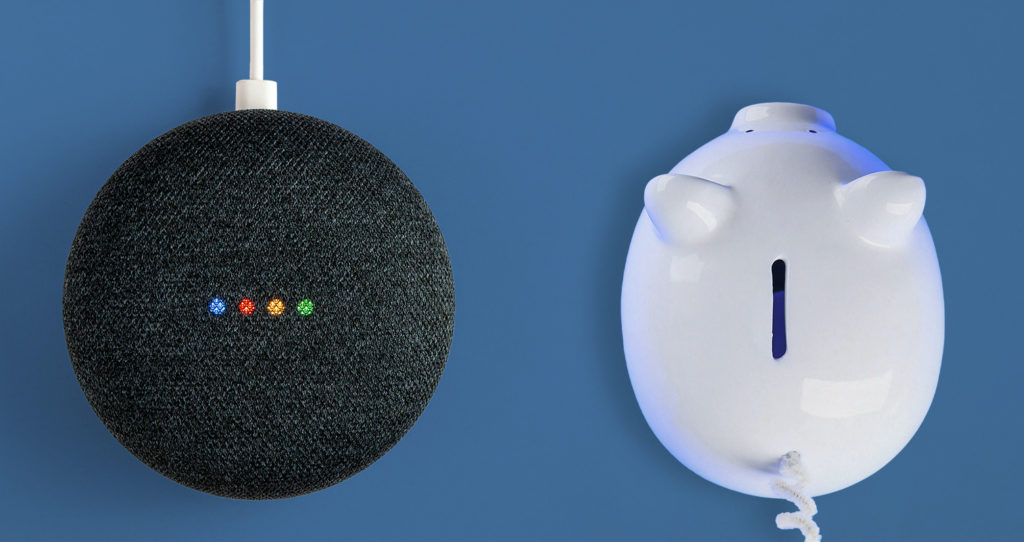
6 Tips for Saving Money and Energy with Smart Home Devices
The path to creating a smart home typically starts as a way to automate tasks and increase control. Take buying a voice assistant, for example. You pick up a Google Home or Amazon Echo, featuring Alexa, just to see what all the fuss is about. Then, you buy a couple of smart plugs for the house, just to give your new assistant something simple to control. Next thing you know, you’re researching products and doing math on all of these investments asking yourself, can all these smart home devices really save me money?
In short, yes. Here are six ways that smart technology can make your home both more cost-effective and energy-efficient.
1) Control power use to reduce your electric costs
Convenience aside, smart plugs can be a real game-changer when it comes to cutting costs. You may have heard the term standby power, or even “vampire power,” in reference to the appliances and chargers we depend on that sap power from our outlets, even when they’re not in use. This applies to smartphone chargers and appliances like televisions and microwaves that run on standby mode waiting for their cue to kick into gear. According to ACEEE, the American Council for an Energy-Efficient Economy, the impact of cutting the power to this classification of devices can be significant.
Since a variety of smart outlets, smart plugs, and advanced power strips can automatically detect and regulate energy outputs, they cut power to any devices not actively in use or running on standby mode. “Because household plug loads can theoretically include an almost infinite number of electronics and electric devices, the potential for plug load energy savings is substantial—up to 50% in some households,” according to an ACEEE report on Energy Impacts in Smart Home Technologies.
2) Monitor your meter to flag potential spikes
Go straight to the source and see exactly where, when, and how your power is flowing with a smart energy monitor.
Have you ever been caught off guard by an unexpectedly high energy bill? A smart energy monitor makes that unwelcome surprise a thing of the past. These connected devices can monitor real-time power consumption that you can check on the go using mobile apps. Appliance detection features can help you see what’s running and when, as well as how much power is being consumed at any given time. This is a great way to start identifying other energy-saving upgrades that can increase your savings.
In addition to impacting your overall savings, this information can also help you gain control over general energy usage in your household.
3) Automate your lights for greater energy efficiency
Lighting is often number one on the to-do list for any household in the early stages of smart home transformation.
Smart light bulbs like Philips Hue make upgrading to automation quite literally as easy as screwing in a light bulb. Setup is simple and works with Nest, Alexa, Google Home, Apple HomeKit, and pretty much any other system you have up and running. And because all smart bulbs are LED, the energy savings are already built in. If you’d rather keep your current bulbs, that’s an easy fix too. Plug your lamps into smart plugs or smart outlets and set your timers and preferences from there. We explore how to take your smart lighting system to a new level through motion sensors and entertainment syncing in Beyond the Bulb: Smart Light Fixtures, Switches, and Accessories.
Setting your lights on a schedule can also help you regulate your family’s routine, signaling moments like bedtime, nap time, or when to get up and get ready for the day. Smart lights also help as a security measure against potential burglars who may be assessing whether or not someone is home. For details on how connected devices can help you increase your home’s security, automated home security devices offer an added layer of protection.
4) Conserve water and lower your bills
According to the EPA, the average family can waste 180 gallons per week from household leaks.
Smart water-leak sensors help you stay on top of any water loss around your home. This, of course, has the added benefit of keeping your home, possessions, and family safe from any potential flooding or mildew damage. These sensors are also beneficial inside your home, alerting homeowners of things like dripping faucets or cycling toilets. More recently, advances in breakthrough technology from companies like Flo by Moen have made these devices more accessible.
When it comes to cost savings and overall efficiency, smart water heaters play a significant role. By sensing your home’s usage patterns, these smart controllers learn when to turn your water heater on and off so that it’s only running when you need it. According to the previously mentioned ACEE energy report, this can “result in savings of 15% of a home’s water-heating energy consumption.”
For homeowners with yards that require regular watering, consider a smart sprinkler controller. This technology can regulate time-of-day usage, automatically stop and start as needed, and make adjustments based on weather. Some advanced versions can even improve your green thumb by setting optimal coverage based on factors like soil condition and plant type.
5) Keep your home’s temperature in check
When it comes to smart thermostats, precision is key.
Unless you’re blasting your air conditioner or heat when you’re not around to enjoy it, upgrading to connected devices like a smart thermostat to control your home’s temperature is more about comfort and convenience than savings. Energy saving in this scenario can only be achieved if your heating and cooling options are precisely partitioned based on your space. However, if you are able to control the temperatures for specific rooms, you’ll be able to make a big difference in regulating the parts of your home that aren’t in need of heating or cooling throughout the day and night.
In any case, a smart thermostat like those from Ecobee or Nest can be a major source of relief in the summer, cooling your space more efficiently by getting the air conditioner prepped prior to your return home. Smart ceiling fans and smart window coverings are two more great ways to keep the heat out and increase savings. Just remember, smart controls are no replacement for ensuring your home has the practical means for optimal temperature regulation, such as proper insulation and tightly sealed windows and doors.
6) Safeguard your smart home automation with fiber internet service
Bear in mind that reliable internet service is key to making sure your smart home is operating safely and efficiently.
One of the best ways to know if your devices are connecting at maximum speed without competing for bandwidth is through a fiber internet service as opposed to traditional cable. In addition to ensuring your smart home devices run effectively, here are 5 reasons you should consider fiber internet service for your home.
Fiber internet uses fiber-optic cables instead of traditional copper wires to transmit a signal. Overall, fiber internet provides quick load times, equally fast download and upload speeds, and high-quality streaming for multiple users and devices. This mix of dependability and speed makes fiber internet service a perfect match for any smart home or aspiring smart home.
From saving money and reducing waste, to general convenience and peace of mind, investing in smart home technology has its perks–for you, your family, and the environment. If you’ have already decided that smart home transformation is right for you, these upgrades will help you stay in control of your home’s power usage, and your energy bills.




Join the conversation